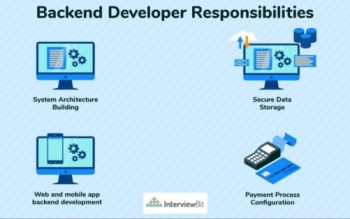Back-End Development refers to the server-side of web applications that handles data processing, storage, and business logic.Key Components of Back-End Development It is responsible for managing the database, server, and application, ensuring that everything works seamlessly together to deliver a functional and efficient user experience. While front-end development focuses on what users see and interact with, back-end development is concerned with the underlying systems that support these interactions.
Key Components of Back-End Development
- Server:
- The server is a powerful computer or system that stores, processes, and serves data to users and clients (front-end). It handles requests from users, processes them, and sends back the appropriate responses.
- Common web servers include Apache, Nginx, and Microsoft IIS.
- Database:
- Databases store and manage data in a structured format, allowing for efficient data retrieval, insertion, updating, and deletion.
- There are two main types of databases:
- Relational Databases: Use structured query language (SQL) for data manipulation and storage (e.g., MySQL, PostgreSQL, Oracle).
- NoSQL Databases: Store data in a non-relational format, which is more flexible for unstructured data (e.g., MongoDB, Cassandra).
- Application Logic:
- This is the core functionality of a web application, implemented through programming languages and frameworks. It dictates how data is processed, rules are applied, and interactions between users and the database occur.
Back-End Programming Languages
Back-end development involves various programming languages, each with its strengths and ideal use cases. Some popular back-end languages include:
- JavaScript (Node.js):
- Node.js allows developers to use JavaScript on the server-side, enabling full-stack development with a single language. It is known for its event-driven, non-blocking architecture, making it suitable for scalable applications.
- Python:
- Python is known for its readability and simplicity. Frameworks like Django and Flask make it easy to develop robust web applications quickly.
- Ruby:
- Ruby, along with the Ruby on Rails framework, emphasizes convention over configuration, allowing developers to build applications rapidly.
- Java:
- Java is a widely used, object-oriented programming language known for its portability and scalability. It is commonly used in large enterprise applications.
- PHP:
- PHP is a server-side scripting language that is particularly suited for web development. It is often used with databases like MySQL and is known for its ease of use.
Back-End Frameworks
Frameworks provide a structured way to build applications, offering reusable components and a foundation for development. Some popular back-end frameworks include:
- Express.js (Node.js):
- A minimal and flexible Node.js framework that provides a robust set of features for web and mobile applications, making it easy to build APIs.
- Django (Python):
- A high-level Python framework that encourages rapid development and clean, pragmatic design. It comes with an ORM (Object-Relational Mapping) for database interactions.
- Flask (Python):
- A lightweight web framework for Python that is easy to set up and scale, making it ideal for small to medium-sized applications.
- Ruby on Rails (Ruby):
- A full-stack web application framework that emphasizes convention over configuration, helping developers to write less code while accomplishing more.
- Spring (Java):
- A comprehensive framework that provides a wide range of functionalities for building Java applications, including web applications and microservices.
APIs (Application Programming Interfaces)
APIs play a crucial role in back-end development, enabling different systems to communicate and share data. They allow the front-end and back-end to interact seamlessly. Key types of APIs include:
- RESTful APIs:
- Representational State Transfer (REST) APIs use standard HTTP methods (GET, POST, PUT, DELETE) for communication. They are stateless and can be easily consumed by various clients.
- GraphQL:
- A query language for APIs that allows clients to request specific data, enabling more efficient data retrieval and reducing the amount of data transferred.
- WebSockets:
- WebSockets enable real-time, two-way communication between clients and servers, making them suitable for applications like chat systems and live notifications.
Data Management
Back-end development involves efficient data management to ensure data integrity, security, and accessibility. Key aspects include:
- CRUD Operations:
- Create, Read, Update, and Delete (CRUD) operations are fundamental for managing data in a database.
- Data Validation:
- Validating user inputs and data formats is essential for maintaining data integrity and preventing errors or malicious attacks.
- Data Security:
- Implementing security measures, such as encryption, authentication, and authorization, is crucial to protect sensitive data from unauthorized access.
DevOps and Deployment
Back-end development also involves deploying applications to production environments. DevOps practices help streamline the development and deployment process. Key practices include:
- Version Control:
- Using tools like Git to track changes in code and collaborate with team members.
- Continuous Integration/Continuous Deployment (CI/CD):
- Automating the integration and deployment process to ensure that code changes are tested and deployed consistently and reliably.
- Cloud Hosting:
- Utilizing cloud platforms (e.g., AWS, Google Cloud, Azure) for hosting applications, providing scalability and flexibility.
Testing and Debugging
Testing is crucial in back-end development to ensure functionality and performance. Common testing practices include:
- Unit Testing:
- Testing individual components or functions of the application to ensure they work as intended.
- Integration Testing:
- Testing how different parts of the application work together, including interactions between the back-end and front-end.
- Load Testing:
- Simulating high traffic to evaluate the performance and scalability of the application.
Conclusion
Back-end development is a vital aspect of web applications, responsible for managing data, application logic, and server communication. By utilizing various programming languages, frameworks, and tools, back-end developers create the infrastructure that supports front-end functionality, ensuring a seamless user experience. As technology evolves, back-end development continues to adapt, embracing new methodologies and best practices to enhance application performance and security. If you have any questions or need further information about back-end development, feel free to ask!

1 thought on “Back-End Development | Key Components of Back-End Development”